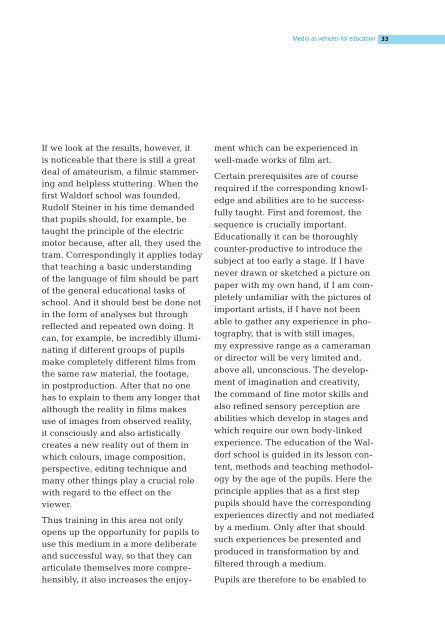Struwwelpeter 2.0
Struwwelpeter_engl_August_2015
Struwwelpeter_engl_August_2015
- No tags were found...
Create successful ePaper yourself
Turn your PDF publications into a flip-book with our unique Google optimized e-Paper software.
Media as vehicles for education 33<br />
If we look at the results, however, it<br />
is noticeable that there is still a great<br />
deal of amateurism, a filmic stammering<br />
and helpless stuttering. When the<br />
first Waldorf school was founded,<br />
Rudolf Steiner in his time demanded<br />
that pupils should, for example, be<br />
taught the principle of the electric<br />
motor because, after all, they used the<br />
tram. Correspondingly it applies today<br />
that teaching a basic understanding<br />
of the language of film should be part<br />
of the general educational tasks of<br />
school. And it should best be done not<br />
in the form of analyses but through<br />
reflected and repeated own doing. It<br />
can, for example, be incredibly illuminating<br />
if different groups of pupils<br />
make completely different films from<br />
the same raw material, the footage,<br />
in postproduction. After that no one<br />
has to explain to them any longer that<br />
although the reality in films makes<br />
use of images from observed reality,<br />
it consciously and also artistically<br />
creates a new reality out of them in<br />
which colours, image composition,<br />
perspective, editing technique and<br />
many other things play a crucial role<br />
with regard to the effect on the<br />
viewer.<br />
Thus training in this area not only<br />
opens up the opportunity for pupils to<br />
use this medium in a more deliberate<br />
and successful way, so that they can<br />
articulate themselves more comprehensibly,<br />
it also increases the enjoyment<br />
which can be experienced in<br />
well-made works of film art.<br />
Certain prerequisites are of course<br />
required if the corresponding knowledge<br />
and abilities are to be successfully<br />
taught. First and foremost, the<br />
sequence is crucially important.<br />
Educationally it can be thoroughly<br />
counter-productive to introduce the<br />
subject at too early a stage. If I have<br />
never drawn or sketched a picture on<br />
paper with my own hand, if I am completely<br />
unfamiliar with the pictures of<br />
important artists, if I have not been<br />
able to gather any experience in photography,<br />
that is with still images,<br />
my expressive range as a cameraman<br />
or director will be very limited and,<br />
above all, unconscious. The development<br />
of imagination and creativity,<br />
the command of fine motor skills and<br />
also refined sensory perception are<br />
abilities which develop in stages and<br />
which require our own body-linked<br />
experience. The education of the Waldorf<br />
school is guided in its lesson content,<br />
methods and teaching methodology<br />
by the age of the pupils. Here the<br />
principle applies that as a first step<br />
pupils should have the corresponding<br />
experiences directly and not mediated<br />
by a medium. Only after that should<br />
such experiences be presented and<br />
produced in transformation by and<br />
filtered through a medium.<br />
Pupils are therefore to be enabled to


